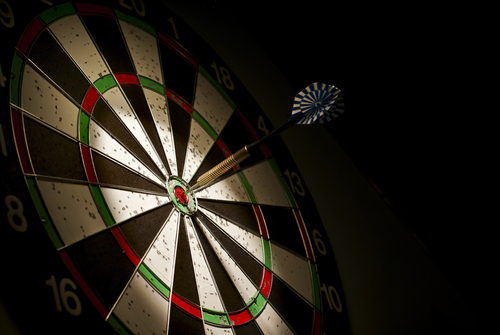
Just how did the game of ‘darts’ come about?

Image credit: New Africa/Shutterstock.com
Darts is a simple game that just about everyone knows and just about anyone can play. From its roots as an old English pub game, ‘darts’ has certainly come a long way. In the last 40 years or so, its popularity has seen it spread to almost all corners of the globe. But, just how did the game come about and why has it become so popular?
In the Beginning
It’s a widely held view that the origin of the game of darts dates back to 14th century England. The tale goes that soldiers would throw spearheads at crude wooden targets, such as upturned wine barrels, in order to kill time when they were out in the field. Gradually, the game became more popular and more formal. Soon, targets similar to those used in archery were adopted.
By the 16th century, the game had moved indoors and was being played in drinking houses across the country. In 1530, it’s famously recorded that Anne Boleyn gave King Henry VIII a set of ornate darts for his birthday. Darts progressed and changed several times over the next few hundred years. Various forms of the game developed and correspondingly, quite a number of different dartboards.
The Modern Game
In 1896, Brian Gamlin, a carpenter from Lancashire came up with a new-fashioned dartboard. The board became and still is the standard for the game of today. In 1898, an American patented the paper dart-flight. This was followed in 1906 by the English metal dart barrel. Now the accuracy which players could achieve was dramatically increased. In the same era, the standard distance between the board and thrower was being established in Southwest England.
The distance was set at three lengths of a beer crate which was 9 feet. It was local brewers Hockey and Sons who supplied the beer crates. Thus, local legend has it that the 9 ft marker became known as the ‘hockey’, and then later as the ‘oche’. Thus, by the early 20th century, darts had pretty much morphed into the game it is today. However, the throwing distance was first reduced to 8 ft, and then eventually to 7 ft 9 1/4”.
After World War I, the game became firmly established in a large number of pubs throughout the country. This paved the way for local leagues to be set up. In 1927, the News of the World newspaper promoted a darts competition for Londoners. Such was the interest and success of the contest, it was immediately opened up to the rest of the country in preceding years. In 1938, total entrants into the newspaper’s competition topped 280,000.
During World War II, darts was particularly popular with servicemen, since it could be played almost anywhere where a board could be set up. It similarly, also became popular with American servicemen, who took the quaint British pub game back to the States. During the 1950s, there was a significant rise in the participation of organized play across the country.
The Influence of TV
In 1954, the National Darts Association of Great Britain was founded. It took up the task of setting up and organising leagues at both the local and national levels. The 1960s saw darts broadcast live on TV for the first time. However, the broadcasting of the 1972 News of the World Individual Darts Championship took the interest in the game to new levels. By the early 1980s, television had created the first darts superstars. The likes of Eric Bristow, John Lowe, and Jocky Wilson had become household names across the UK.
Darts also became a popular pub game in countries with strong links to the UK. This was particularly true in countries such as Australia, New Zealand, and Canada. However, thanks to television and sponsorship, the game has gained an amazing level of popularity in recent years across new frontiers. The game is now popular across Europe, the Middle East, and even parts of China.
Thousands of fans now flock to huge-capacity arenas for major competitions. Millions more devotees tune in on television. Players now have nicknames like the Viking, the Iceman, and Snakebite. They sound more like they belong in the wrestling ring rather than standing by to line up at the ‘oche’. However, darts players now ‘fight it out’ at venues around the world for big money. Prize pots can top £2.5 million for major competitions.
It would seem darts has come a long way since it was just another British game pub game a century ago!
Header image credit: Sergii Gnatiuk/Shutterstock.com
If you’ve enjoyed reading this post, why not check out more of the articles in the series by clicking the following link: Why do we…….?





